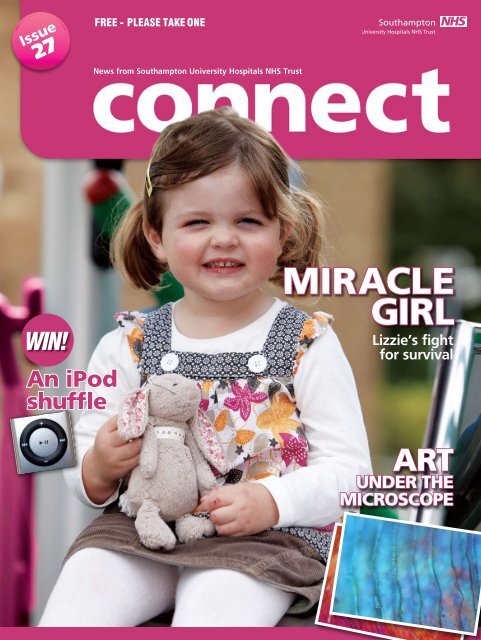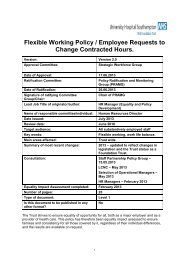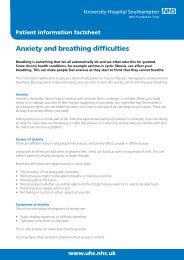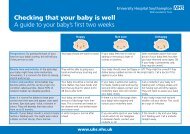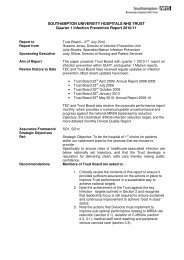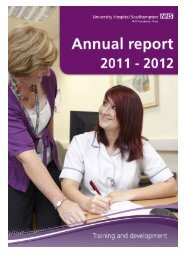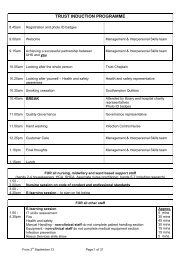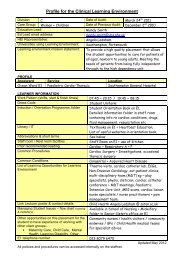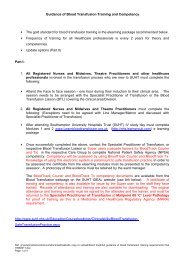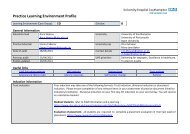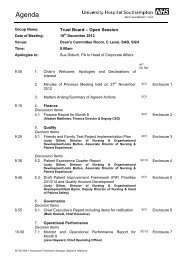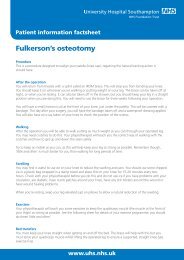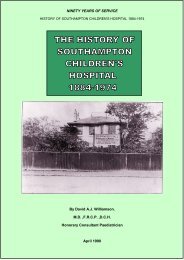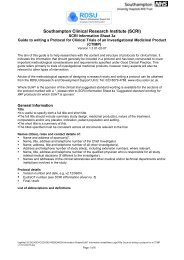Connect issue 27 - University Hospital Southampton NHS ...
Connect issue 27 - University Hospital Southampton NHS ...
Connect issue 27 - University Hospital Southampton NHS ...
You also want an ePaper? Increase the reach of your titles
YUMPU automatically turns print PDFs into web optimized ePapers that Google loves.
mediamonitorthe latest SUHT newsWelcome to <strong>issue</strong><strong>27</strong> of <strong>Connect</strong>In this <strong>issue</strong>...SUHT in the news 2<strong>Hospital</strong> open day/Hands-free CPR 3Miracle girl Lizzie 4/5Journey of a biopsy/Cycle to Work 6Growth of “sci-art”/Spouting off 7Dear <strong>Connect</strong>/The fundraising connection 8Tell us what you think...Let us know what you think of <strong>Connect</strong>,plus tell us what news and features you’dlike to see in future editions.Email connect@suht.swest.nhs.ukWrite toCommunications, Mailpoint 18,<strong>Southampton</strong> General <strong>Hospital</strong>,Tremona Road, <strong>Southampton</strong> SO16 6YDTelephone 023 8079 4853Website www.suht.nhs.uk<strong>Connect</strong> is produced by SUHT’scommunications team.MediaMonitorTop children’s surgeon says ‘poverty’ bonedisease has returned in <strong>Southampton</strong>A poverty-linked bone disease thatdisappeared over 80 years ago, butresurfaced in northern parts of theUK this year, is now being discoveredin high numbers of young patients in<strong>Southampton</strong>.MediaMonitorRickets, a condition that causeschildren’s bones to become weakand bowed, was endemic in poorVictorian England, but was writtenoff by many orthopaedic surgeons by1928 followingthe discovery ofvitamin D in 1922.However, thedisease is nowmaking a comebackdue to low vitaminD levels causedpredominantly bylack of exposure tosunlight and alsopoor diet – thoughit had not beenuncovered in<strong>Southampton</strong> untilnow.This vitamin,found in a smallnumber offoods, isimportant insupportinggrowth andmaintainingstrongbones.“The return of rickets in northernparts of the UK came as a surprisedespite the colder climate and lowerlevels of sunshine in the north, butwhat has developed in <strong>Southampton</strong>is quite astonishing,” said consultantorthopaedic surgeon ProfessorNicholas Clarke.“In my 22 years at <strong>Southampton</strong>General <strong>Hospital</strong>, this is a completelynew occurrence in the south that hasevolved over the last 12 to 24 monthsand we are seeing cases across theboard, from areas of deprivation upto the middle classes, so there is a realneed to get national attention focusedon the dangers this presents.”media monitor: This story was covered by The Daily Telegraph, the Daily Express, the Daily Mail, The Sun, the Daily Mirror, BBC News (TVand online), BBC Radio Solent, Heart FM Hampshire, Wave 105 FM, the Daily Echo, ITV Meridian and Medical News Today.Expert partof glaucomabreakthroughOne of <strong>Southampton</strong>’s leadingeye specialists is part of a teamof international experts that hasdiscovered a gene mutation thatcauses glaucoma.Professor Andrew Lotery, fellowconsultant ophthalmologists at<strong>Southampton</strong> General <strong>Hospital</strong>’seye unit and scientists at the<strong>University</strong> of <strong>Southampton</strong>, alongwith colleagues in Iceland, Australia,Hong Kong, China, Sweden and theUSA, have all contributed to theresearch, which may lead to earlierdetection of the condition.MediaMonitormedia monitor: This story wascovered by the Daily Express,the Daily Echo, ITV Meridian, TheBreeze 107.8 FM, Optician Online, MedicalNews Today and Optometry Today.MediaMonitor<strong>Southampton</strong> heart experts implantEurope’s first ‘slinky’ stentHeart specialists at <strong>Southampton</strong>General <strong>Hospital</strong> recently becamethe first in Europe to implant aninnovative ‘slinky’ coil to open apatient’s blocked artery.Stents are used to create permanentblood flow in previously blockedarteries of coronary heart diseaseor heart attack patients duringangioplasty, a procedure in whichcardiologists inflate an artery witha small balloon, clear it and insert apermanent coil.The new advanced design, known asthe Resolute Integrity Stent System, ismore flexible than other types and canbe used to reach narrow or difficultblood vessels – its bendy design alsomeans it has an improved ability tomould to the shape of an individual’sMediaMonitormedia monitor: This story wascovered by the Daily Echo, BBCRadio Solent, Heart FM, Wave 105 FM, thePress Association, Medical News Today,the Belfast Telegraph, Irish Daily Star and<strong>Hospital</strong> Management.MediaMonitorartery rather than remain rigid.Consultant cardiologist Dr IainSimpson, who performed the firstprocedure using the coil, said: “Thenew stent is more flexible for gettingaround twisty arteries, giving usanother option when treating patientswith coronary heart disease or thosewho have suffered a heart attack.”The Daily Echoran a front pageand double-pagespread on plansfor <strong>Southampton</strong>General <strong>Hospital</strong>to become one ofonly a handful ofnew major traumacentres, which willsee critically illpatients from acrossthe region broughtdirectly to the cityfor specialist care.Reproduced with kind permission of the Southern Daily Echo2 CONNECTISSUE <strong>27</strong>When you have finished with this magazine please recycle it. Printed on environmentally friendly paper.
This was the second year running staffat <strong>Southampton</strong>’s teaching hospitalswelcomed people through the doorsand the event did not disappoint,with over 2,000 visitors experiencingthe ‘patient journey’.Visitors came from as far away asBirmingham, Exeter, Surrey and evenDenmark to enjoy the day.A welcome addition this year wasa giant inflatable colon manned bycolorectal surgeon Alex Mirnezami toraise awareness of colon cancer.Other attractions included theopportunity to scrub up on thetheatre tours, get arms plasteredin the casting room and lookthrough the world’s most powerfulmicroscopes in the biomedicalimaging unit.Teddy bear hospital proved a hit withthe kids and saw a large number ofpatients during the day, all of whomresponded well to treatment!Children also had the chance totest their steady hand skills on giant“Teddy bear hospitalproved a hit with thekids and treated a largenumber of patientsduring the day<strong>Hospital</strong> open dayattracts over 2,000 visitorsMembers of the public had another opportunity to see behind thescenes of their local hospital at this year’s action-packed open day.versions of games Operation andBuzzwire.Those interested in a future careerinfigures2,000 visitors180 staff involved200 arms plastered400 faces painted600 teddies treated1,200 tour slotsin the <strong>NHS</strong> had the chance toexperience working life in many fieldsof medicine, including the eye unit,cystic fibrosis, pathology and cardiacshort stay.The <strong>University</strong> of <strong>Southampton</strong>’sschool of medicine opened its doorson the day, showing how closely wework on research projects.The Wellcome Trust Clinical ResearchFacility and the <strong>Southampton</strong> CancerResearch UK Centre demonstratedhow treatment is taken straight fromthe laboratory to our patients.Mark Hackett, chief executive, said:“This event gets bigger and bettereach year. The open day was a greatopportunity for the community tocome in and see how their hospitalfunctions on a daily basis and whywe are a world-class centre for bothtreatment and research.“Once again, feedback has beenexcellent and this event has becomea regular feature in the hospitalcalendar.”Hands-free CPRAnyone who has ever experiencedgiving cardio pulmonary resuscitation(CPR) will know how difficult it canbe – but a new hi-tech gadget at<strong>Southampton</strong>’s teaching hospitals isrevolutionising practice.Staff in the cardiac catheter laboratoryat <strong>Southampton</strong> General <strong>Hospital</strong> areusing an innovative mechanical CPRdevice that provides chest compressionsautomatically, cutting out the need forhands-on involvement.CPR is given during a cardiac arrest– when the heart beats abnormally orstops – to try to restore blood circulationaround the body and deliver oxygento the t<strong>issue</strong>s. It is achieved by use ofa defibrillator to correctrhythm and externalcardiac massage,where, traditionally,a personrepeatedlypushesup anddown onthe chestto promotebloodflow.Thisbecomesa problem,though,when a patientgoes into cardiacarrest during treatment for a heart attackbecause they require continuous x-rayexamination that staff cannot be exposedto, meaning CPR cannot be maintainedand the procedure is halted.But the new machine – Autopulse– gives a cycle of chest compressionsindependently and allows a short breakfor the patient to be given oxygen.“Autopulse offers the heart attack teamthe opportunity to continue treatingsome of the most severely unwell patientswhen, in the past, their procedure mayhave been stopped in order to allowmanual CPR to be undertaken,” saidconsultant cardiologist Dr Huon Gray.As part of the heart attack procedure,a tube is inserted into the body throughwhich drugs and specialised devices suchas stents can be delivered and bloodpressure can be accurately measured.During a recent procedure for thetreatment of a heart attack patient, DrGray and his team were able to see howeffective Autopulse was through bloodpressure readings when the patient wentinto cardiac arrest.He said: “The device achieved bloodpressure readings twice as good as thosewe had initially been achieving withexternal manual CPR and, while the needfor such a machine is very rare, it canmake the difference between being ableto continue with a life-saving procedureor not.”Photograph courtesy of ZOLL.CONNECTISSUE <strong>27</strong>3
MiraclegirlIt was the moment they thought they would never see.Three-year-old Lizzie Rodway’s parentsfeared they could lose their preciousdaughter after she was horrifically injuredin a car crash, but now – just monthslater – she is back at pre-school andcaring for her favourite toy bunny.Though it could have been so differentfor mum Karen and dad Adrian followingthe accident on their way home froma family holiday at Longleat, which leftLizzie with life-threatening head injuries.While her parents were taken byambulance to Salisbury District <strong>Hospital</strong>and given the all-clear soon afterwards,Lizzie was flown in by air ambulance asher condition was rapidly deteriorating.A call was made to <strong>Southampton</strong>General <strong>Hospital</strong>’s specialist paediatricintensive care unit (PICU) and a teamled by Dr Iain Macintosh arrived in theirdedicated PICU ambulance to collect her.Lizzie’s injuries included a significantskull fracture and multiple facialfractures. In addition, the damage to herhead was complicated by poor bloodflow to the brain.“We arrived at <strong>Southampton</strong> dazedand confused,” said Karen, of Ilton inSomerset. “Our clothes were in tatters,having been cut in hospital, and then wewere faced with the prospect of thinkingwe were going to lose our daughter.”Although given some initial hope fivedays later when Lizzie was deemed stableenough to be moved out of PICU, shetook a turn for the worse and was rushedCONNECT4 ISSUE <strong>27</strong>
“Bursledonfor surgery to remove part of her skulldue to dangerous levels of brain swelling.“Lizzie came to us with an array ofcomplex injuries, but the addition ofsevere brain swelling created furtherconcerns,” said consultant neurosurgeonDorothy Lang.“It was vital we were able to removepart of her skull so quickly, as swellingin any patient, let alone a very youngchild, causes pressure inside the headto become critically elevated, denyingthe brain of the sufficient oxygen andnutrients it needs to survive.”As a result of having a section ofskull removed, Lizzie was fitted with aprotective helmet to cover the vulnerablearea until the swelling had subsidedenough to have a metal plate replace hermissing bone.The helmet became a symbol of herrecovery for Karen and Adrian, both 30.After a further three days in intensivecare following surgery, Lizzie was movedto the paediatric high dependency unitand then the paediatric medical unit,where she spent the next 11 weeksrecovering and undergoing rehabilitation.Given the nature of Lizzie’s head injuriesand her age, not only did she require theservices of the neurosurgeons, but alsoearly intervention by consultant paediatricneurologist Professor Colin Kennedy andhis specialist team to manage repair ofher brain function.“We have to take advantage of everyopportunity that arises in the naturalcourse of brain healing to capitalise onthe flickers of function that first appear toengage the recovering parts of the brainin useful activity – this can begin even asearly as on PICU,” he said.“This reinforces their ability to functionwhich, in turn, increases the amount ofrecovery that can be achieved.”When the physiotherapy team begantheir work in the early days of admission,Lizzie was unable to even lift her head orsit up.Damage to her brain from the crash inFebruary affected her functional ability,meaning she suffered problems sendingmessages to the left side of her bodyfrom her head down.Karen explained: “Lizzie was receivingphysio twice a day and occupationaltherapy twice a week. This proved to beas tough a time for us as the worst earlydays when we thought we would loseher, as we were faced with not knowingif she would walk again, have any use ofher left arm or sight in her right eye.”House will always be a specialplace, as it is where we saw Lizzie take herfirst independent steps again…But, two and half months after theaccident, Lizzie was fit enough to moveacross to <strong>Southampton</strong> <strong>University</strong><strong>Hospital</strong>s <strong>NHS</strong> Trust’s specialistrehabilitation centre, Bursledon House,where staff accommodated Karen in afamily room with her daughter.During her time at the centre, Lizziemade good physical progress and beganto regain the ability to walk, talk, playand laugh.“Bursledon House will always be aspecial place, as it is where we sawLizzie take her first independent stepsagain and then become more and moreconfident on her feet – it is also whereshe spent most time with her protectivehelmet, which became an iconic symbolof her journey,” said Karen.As her stay in <strong>Southampton</strong> neared fivemonths, the swelling onher brain had reducedand her therapy wasproducing good results,so Lizzie underwentsurgery to replace themissing bone in her skullwith a custom-madetitanium plate createdon-site.Jenni Palmer,paediatric neurologyphysiotherapist, said:“After intense work,Lizzie has made anexcellent physicalrecovery here and isnow able to standindependently, walkindependently whilewearing a splint onher left foot to aidbalance and is startingto incorporate the useof her left arm into day to day activitiesand play, which is fantastic.”A week after having her plate fitted,Lizzie was back at home and has sincebeen receiving weekly physiotherapy andoccupational therapy in Somerset.Karen, who has now taken acareer break from her job as a senioraudiologist to care for Lizzie, added:“We’re all finding it a little strangesettling into our new normal life back atBursledon Househome, but Lizzie is coping wellwith her continuing therapy.“We just feel so indebted to allof the staff. If there was not such awonderful team, I really think we wouldnot have our beautiful daughter herewith us today.”Karen and Adrian are now raisingfunds for the paediatric medical unitand paediatric physiotherapy teamthrough <strong>Southampton</strong> <strong>Hospital</strong> Charity.Dr Claire Phillips, the associate specialist in paediatrics who oversawLizzie’s care in Bursledon House, said: “In Bursledon House we areable to provide a more homely environment in which to continue therehabilitation started on the wards. Lizzie was able to continue to haveher intensive therapeutic input while also starting to do more of thenormal things a lively three-year-old girl should be doing and we aredelighted to see her doing so well.”SIX MONTHS IN THE LIFE OF LIZZIE RODWAYCar crash onway backfrom holidayin Longleat,airlifted toSalisburyDistrict <strong>Hospital</strong>Team fromSGH arrivein dedicatedambulance tobring her backfor specialisttreatmentFive days inPICU withsignificant skullfracture andmultiple facialfracturesHer immediatecare involvedsurgeons fromneuro, oral andmaxillofacialandophthalmologySwelling on thebrain requires apiece of skull tobe removedGiven aprotectivehelmet untilswellingsubsides andtitanium platecan be fittedFurther threedays in PICU,moved topaediatric highdependency andthen paediatricmedical unitSpent the next 11weeks recoveringand rehabilitatingwith help ofconsultants,nurses andphysiosRequired skillsof renownedneurologist ProfColin Kennedyto repair brainfunctionTwo and halfmonths afteraccident,Lizzie movesto BursledonHouse Children’sCentreMum Karenstayed withLizzie atBursledonHouseShe madegood physicalprogress andbegan to regainthe ability towalk, talk, playand laughAt five months,Lizzie was ableto have thetitanium platefittedA week later,she returnedhome with herparents andhas continuedtherapy in thecommunityIs now back atpre-school andplaying withher favouritetoys againCONNECTISSUE <strong>27</strong>5
The journey of a biopsyHave you ever wondered what happens to a biopsy specimen at the laboratory?Dr Adrian Bateman, consultant histopathologist, explains how one is processed.1The first stepThe specimen arrives at themain pathology reception andis recorded on computer. Theaudit trail starts here, witheach specimen given a uniquenumber for identification. Itis then sent to the specimendescription and dissectionroom. Almost all specimens arereceived in a formalin solution,which preserves the specimenthroughout its journey.30,000The number of specimenrequests the pathologydepartment at SUHT dealswith in a year, one of thebusiest in the UK. This equatesto approximately 600 perweek and 100 per day.2 3 4It’s all aboutpreparationA pathologist or biomedicalscientist records thecharacteristics of thespecimen. For large specimens,representative t<strong>issue</strong> samplesare chosen to create microscopeslides; for small biopsies, all thematerial is used in the slidemakingprocess.The t<strong>issue</strong> to be processed isput into small colour-codedcontainers, which indicatesinformation such as thespecimen type and how quicklyit needs to be dealt with. Forexample, green equals urgent.The specimen is thendeposited into a machine,which uses a chemical process toremove water and impregnateit with paraffin wax, whichsupports the t<strong>issue</strong> and makesit possible to prepare sections.This process can take betweenone to 12 hours.A good cutBiomedical scientists use amachine called a microtome(similar to a hi-tech bacon slicer)that cuts into the paraffinblocks to create very fine t<strong>issue</strong>strips that float into a waterbath. These strips are thenplaced onto a glass slide usingforceps and stained – mostcommonly with a combinationof pink and blue – so thatthe cells can be seen under amicroscope. A thin glass ‘coverslip’ is put onto the specimen toprotect it from scratches.The slides are checkedfor quality, labelled andentered into the audit trail asbeing ready for microscopicexamination. These sections arekept in the hospital archives for15 to 20 years, although they dofade with time.DiagnosisThe slide is ready for diagnosisand sent to a histopathologist.Using a microscope, theyexamine the t<strong>issue</strong> sections onthe glass slides and interpretthe appearances of these inthe context of the clinicalinformation about the patient– e.g. the patient’s medicalhistory, why the biopsy wastaken, and what the results ofother tests have been.Histopathological examinationis usually seen as the goldstandard for the diagnosisof many cancers and noncancerousdiseases.A pathology report is createdand sent back to the patient’sGP or to the hospital doctorwho requested the biopsy.The whole process takes two tofive days, but longer if additionaltests are required on the t<strong>issue</strong>.In emergency situations, thisprocess can be a lot quickerthrough the use of frozenspecimens – this is when thespecimen is cut into sectionsafter freezing rather thanbeing set in wax. This methodcan give doctors results abouta patient during an operation,but the quality of specimensin this process are not as goodand do not last, which is whythis process is only used inclinical emergencies.On your bike!Enda Smyth, a nurse inthe paediatric assessmentunit, has made it hismission to encourage usto get on a bike throughthe Cycle to Workscheme.“I am from a one-carfamily and have threedaughters and a wife tocontend, so I take the option of cycling11 miles from home in Winchester,”he said.“I am fitter and healthier than everand feel, with a bike, mudguards and ahelmet, anyone could join me in cyclingto work.”If you’d like to join Enda and find outmore about the Cycle to Work scheme,visit www.cyclescheme.co.ukCONNECT6 ISSUE <strong>27</strong>
““Having<strong>Hospital</strong> atthe centreof growingmodernart formIt’s not every day a teaching hospitalcan lay claim to some of thecountry’s finest modern artwork.But a novel collaboration betweena laboratory team based at<strong>Southampton</strong> General <strong>Hospital</strong> andleading professional artists makesthat a reality.Although better known for indepthanalysis of medical samples andbiopsies using some of the world’smost powerful microscopes, thebiomedical imaging unit (BIU) has agrowing attachment with the arts.And that is inpart due to clinicalscientist and head of the BIU DrAnton Page’s desire to see sciencepromoted in a more user-friendly way– which has led to a growth in “sciart”across the south.“Havingartistsworkingwith usprovidesa different perspective on our workand helps us to look at things in adifferent way. It can also create somefierce debate about the way welook at things and how we interpretthem,” he said.artists working with us provides adifferent perspective on our work and helpsus to look at things in a different wayMartha DaviesMartha Davies photographselements of life under highmagnification using advancedmicroscopes in the BIU.Her detailed examination ofspecimens creates an enhancedview of reality by emphasising thestructures that exist in life forms.Martha’s fish scale images -displayed above - were formedwith a microscope that allowsartists to view and photographcertain materials usingpolarised light.“The only real difference betweenus as scientists and the art worldis probably one of language; ascientific training teaches you to bevery precise and to-the-point in yourwording and descriptions, whereasA light is shone through aspecimen so the colours and structurecan be seen though the eyepiece,then a digital camera within themicroscope collects images.“art-speak” isoften much more obscure.”And Dr Page’s vision of joiningforces to advance scientificunderstanding has resulted in fourcurrent collaborations with popularartists Pauline Pratt, Martha Davies,Kathleen Rogers and Seran Kubisa.Their works involve intricatemanipulation of a range of objectsthrough the use of electron andlight microscopes, producingabstract images for exhibitionaround the UK.More information on the sci-artpartnership can be found atwww.som.soton.ac.uk/research/sites/biu/collaboration/CASESTUDYAfterwards, colourscan be altered usinga dial on the microscope, so thesame photograph of a section canbe taken again to produce differenteffects.“The fish scales show a structurebut also, importantly, the colourthey give off shows that there ismore detailed information withinthe scale. Using the polarisingmicroscope allows me to engagewith the beauty inherent in naturalobjects,” said Martha.Spoutingoff with…Dr Mark Wright“All good thingscome to an end” –that’s what I toldmy little boy afterhis 10th birthdayparty. It’s a curiousexpression, one I pickedup from my history teacher. He wasreferring to the Roman Empire.At the party, I had some thoughtsabout what’s happening in the <strong>NHS</strong>(really, I did).After the kids filled up on fizzy drinksand chocolate, I still had 30 minutes tofill. I thought musical chairs would befun. It was. To start with.To start with there are plenty ofchairs – like any resource really. Thenthe chairs start disappearing. Noone’s too bothered at first, but slowlypeople start paying attention.All of a sudden there are not enoughchairs. Then the fighting starts and, ifyou’re not careful, you end up withtears and a wrecked house.One idea would be to get thosewithout chairs to start clearing up. Abit like getting the unemployed topick up litter I suppose…Then I started thinking about the fall ofRome and parallels with the <strong>NHS</strong>. Bothfounded on a noble idea, both workedwell based on the work of slaves.When the working time directiveemancipated all the slaves (juniordoctors), all of a sudden there wasa shortage of bodies and underinvestment meant there was notechnology to fill the productivity gap.In desperation they turned tobarbarians to guard the frontier,resulting in the hospital being overrun.The republic was bankrupt. The citizensblamed the managers. The managerswere thrown to the lions for thegratification of the public/frontline staff.Eventually the Coliseum ran out ofmanagers and had to resort to throwingthe public/frontline staff to the lions…Blimey, what do they put in thiscoffee? I’m going back to work now –don’t want to be the only one withouta chair when the music stops.*If you have a burning <strong>issue</strong> you’dlike to get off your chest emailconnect@suht.swest.nhs.ukCONNECTISSUE <strong>27</strong>7
talkbackiFind out more... Sign up to <strong>Southampton</strong> <strong>Hospital</strong> Charity’s newsletter to receivemore news and fundraising information. Email charity@suht.swest.nhs.ukDear <strong>Connect</strong>An unfortunate accident on afriend’s stag weekend in Cardiffleft me on the floor with bloodstreaming through a deep andserious cut on the side of my righthand through to my middle finger.Fast forward 24 hours and Ifound myself in <strong>Southampton</strong>General <strong>Hospital</strong>’s emergencydepartment, complete withmedical notes from the previousday in Wales.I knew my fate early on: I hadto have an exploratory operationto determine to what extent Ihad ruptured the two tendons inthe finger, see if I had any otherfurther damage to the nervesand then undergo repair.As an accident-prone person,I have never been a fan of beingin hospital, so when informedmy operation was scheduledin for the Wednesday, withthree days on a ward, to sayI was apprehensive was anunderstatement.The day before I was due forsurgery, I was introduced toresearch nurse Kerry Gunner,who informed me that theinjuries I had sustainedqualified me to be part of a newmedical trial.The hospital wanted to trial amechanical lubricant that wouldbe injected into the tendon onrepair to test whether it couldhelp improve the healing processand improve mobility of thefinger once fully healed.As well as Kerry, I also metthe surgeon who would beperforming the operation, DavidWarwick (pictured left).David made me feelcompletely at ease andexplained everythingsimply and effectively.The aftercare Ihave received hasbeen superb; sincesurgery, I have beenattending regular physioappointments at theRoyal South Hants <strong>Hospital</strong> andalso medical trial sessions.For the duration of my stay,all the nurses made me feelwelcome and made my staya lot smoother. They were allvery friendly and if I knew theirnames, I would individually thankthem all.In the future, if I have to stayovernight in any hospital, I hopeit is <strong>Southampton</strong> General!The fundraisingconnectionCall <strong>Southampton</strong> <strong>Hospital</strong> Charity on 023 8079 8881 or visit www.suht.nhs.uk/charity<strong>Southampton</strong> expert scalesKilimanjaro for her baby unitIn October, the region’s top babyspecialist took on a mountainof a challenge to raise funds forthe neonatal intensive care unitat <strong>Southampton</strong>’s Princess Anne<strong>Hospital</strong>, which provides care toover 700 newborn babies fromacross the south every year.Consultant Dr Alyson O’Donnellheaded up a team of parents,nurses, doctors and friends of theunit to scale Tanzania’s MountKilimanjaro, the world’s tallestfree-standing mountain, in a tendaytrek.Although just the beginningof their fundraising efforts, theultimate goal is to raise over£100,000 for <strong>Southampton</strong><strong>Hospital</strong> Charity to improveparental accommodationSudoku challengeWin an iPod shuffleso families are given the bestpossible environment in which tounwind while their child is treated.“The trip was absolutely amazing,if one of the most demandingthings I’ve ever done, with 18 outof the 21 making it to the summit,”said Dr O’Donnell, the divisionalclinical director for women andchildren at <strong>Southampton</strong> <strong>University</strong><strong>Hospital</strong>s <strong>NHS</strong> Trust.“The summit night was a realslog, but it was quite magicalseeing the line of head torchessnaking up the mountain – thoughit’s a good thing they make youclimb it in the dark as it means youcan’t see quite how far it is!”Among the adventurers wereRichard Weatherly, RichardCroucher and Ross Cawte, threefathers who have experiencedfirsthand the care the unit provides.WIN!Enter numbers from 1 to 9 into the blank squares, so that every row,every column and every 3x3 square has one of each digit.Send your entry in the internal post to <strong>Connect</strong>, Mailpoint 18,to be in with a chance of winning a 2GB iPod shuffle donated byKiteleys Solicitors. Entries close Monday 20 December 2010.“We know how importantit is for parents to haveaccommodation near or on theunit and we wanted to givesomething back to say thank youfor all the help and support theygave us during our six-week stay,”said Mr Weatherly, whose sonThomas recently celebrated hisfirst birthday.Thanks to the fundraisingefforts of all those who took partin the Kilimanjaro challenge, over£30,000 has been raised.Dr O’Donnell added: “Weare going to keep the schemeopen and will be looking foradditional adventures to keep themomentum going towards our£100,000 target.”To make a donation, pleasevisit www.justgiving.com/pahneonatalchallengeWant to challengeyourself and raisemoney for<strong>Southampton</strong><strong>Hospital</strong> Charity?Places now available for:• Skydive for Father’s Day –19 June 2011• Cycle London to Paris –14 to 18 September 2011• Trek Peru – 3 to 12November 2011.Email suzie.pearce@suht.swest.nhs.uk for moreinformation or visitwww.suht.nhs.uk/charity/getinvolvedJames Forder24, from <strong>Southampton</strong>


